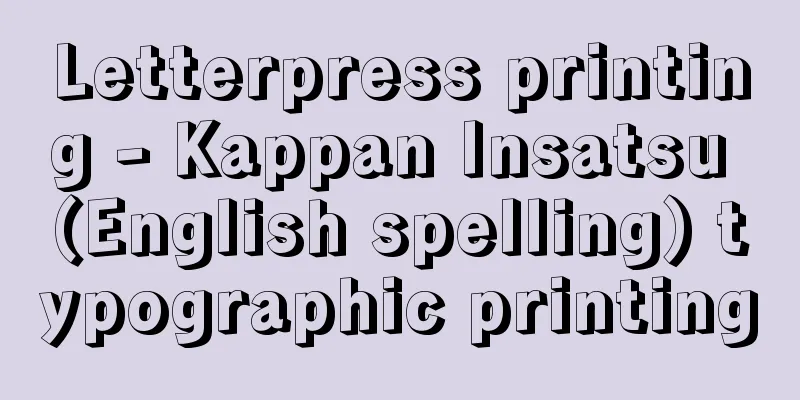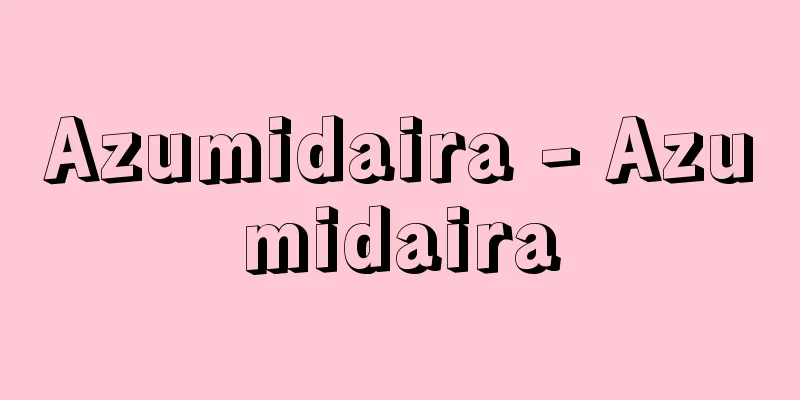Letterpress printing - Kappan Insatsu (English spelling) typographic printing

|
Letterpress printing is a method of printing primarily letters using movable type, and since its invention by Gutenberg, it has been the mainstream method of printing books, magazines, newspapers, etc. It surpasses lithographic printing in terms of the elegance, readability, and beauty of the printed matter, but in terms of plate-making efficiency, production costs, and other factors, it has been replaced by offset printing, which uses photography and electronic technology, since around 1980. Typesetting using letterpress involves the first process of collecting the necessary type (bunsen), arranging the collected type according to the manuscript and adjusting the line and character spacing (typesetting), and creating duplicate plates for printing a large number of copies. It is said that there were more than 40,000 types of type in total, but normal printing used around 6,000 to 7,000 types. These are placed in type cases and placed on the case stand. Type can be arranged by phonetic classification, but is usually arranged by radical. The case for the most frequently used type is called the large extension (oshutcho) and is placed in the location where it is easiest to type. The next most frequently used type is called the small extension (ko) and is placed nearby. There are also cases for external characters (characters used less frequently), hiragana, katakana, and numbers. Bunsen is the process of placing type selected from the type case into a shallow bunsen box. The typesetting process involves adding punctuation, ruby (characters for reading furigana), symbols, and lines to the selected type, and arranging it into the specified format. Spaces are added between characters, and interline leads are added between lines to make it easier to read. In addition, quadrats, justifiers, and formatstegs are used to fill in blank spaces in the plate. Quadrat are used for blank lines or at the end of lines, joss are larger, and formatts are used to fill even larger blank spaces. These are made short so that they do not get ink on them when printing. These are then organized on a composing stick, which is then transferred to a galley and assembled into a page. A galley is a thin box in which type is placed, and proofs and small runs are printed while still set on the galley. A proof is sometimes called a galley print, or galley, which is a corrupted form of the English word galley. The proof print is compared with the manuscript and any necessary corrections are made, and the correct type is replaced before the actual printing begins. For large runs, a duplicate plate is made. For small runs, the typesetting plate is attached to the printing press and the print is made directly. In newspaper printing, the mainstream method was type → paper → round lead plate → rotary press printing, but around 1980, this shifted to computerized typesetters and offset printing. [Fumio Hiraishi and Ryutaro Yamamoto] "Hisana Kawada, 'The History of Letterpress Printing' (1981, The Society of Printing Science and Technology Publishing Division)" ▽ "Atsuo Aoyama, 'Letterpress Printing Travelogue: Christian Printing Highway' (1999, The Society of Printing Science and Technology Publishing Division)" [References] | | | | |The type is picked up one by one from the type case according to the manuscript and collected in a selection box. An experienced person can pick up about 2,000 characters of 9-point type per hour . The process of letterpress printing (1) Text selection The type collected during the selection process is used to insert punctuation marks and lines according to the instructions of the manuscript and layout, and to adjust the spacing between characters and lines. This is also called typesetting . The process of letterpress printing (2) Typesetting After the typesetting is completed, ink is applied directly to the type plate, a proof (galley proof) is printed, and the book is proofread. ©Shogakukan Letterpress printing process (3) Proofreading After proofreading and correction of typos, the type plate is pressed onto a paper mold and copied onto a paper mold (intaglio). Lead is poured into the paper mold to create a lead plate, which is then used as a printing plate. ©Shogakukan "> Letterpress printing process (4) Paper mold making A sheet-fed letterpress press prints sheets of paper one side at a time. It can print 5,000 sheets per hour. For newspapers, magazines, and other items that need to be printed in large quantities in a short time, a rotary letterpress press is used, which prints both sides of a roll of paper at the same time . Letterpress Printing Process (5) Book Printing This machine automates the processes of casting type, selecting text, and typesetting. The machine reads the manuscript that has already been punched onto tape, and instantly casts and arranges the type, character by character, from molten lead. It can cast approximately 6,600 characters per hour. ©Shogakukan "> Automatic casting machine Source: Shogakukan Encyclopedia Nipponica About Encyclopedia Nipponica Information | Legend |
|
活字を使い、文字を主体とする凸版印刷で、グーテンベルクの発明以来、書籍、雑誌、新聞などの印刷の主流をなしてきた。印刷物の格調の高さ、読みやすさ、美しさなどの点で、平版による文字印刷をしのぐが、製版の作業能率、生産費その他の点から、1980年ごろより写真・電子技術を用いるオフセット印刷にとってかわられた。 活版の組版では、まず必要な活字を集める(文選(ぶんせん))、集めた活字を原稿に従って配列し、行間・字間を整えて配置する(植字)、大部数の印刷には複製版をつくる、の工程がある。活字は総数4万種以上あったといわれるが、普通の印刷では6000~7000種程度であった。これを活字ケースに収め、ケース台に置く。活字の配列は、音別分類もあるが、普通は部首別である。使用頻度のもっとも多い活字のケースを大出張(おおしゅっちょう)とよび、もっとも採字しやすい場所に置く。次に多いものを小(こ)出張とよび、その近くに置く。そのほか、外字(がいじ)(使用頻度の少ない文字)、平仮名、片仮名、数字のケースもある。文選は、活字ケースから選んだ活字を浅い文選箱に入れる作業である。植字作業は、文選した活字に句読点、ルビ(振り仮名用活字)、記号、罫線(けいせん)を加え、指定された体裁に組み込む。字間にスペースspace、行間にインテルinterline leadsを入れて読みやすくする。また、版の空白部を埋めるため、クワタquadrat、ジョスjustifier、フォルマートFormatstegを使う。クワタは空白の行や行末に使い、ジョスはさらに大きい、フォルマートはいっそう大きい空白部を埋めるのに用いる。これらは印刷時にインキがつかないよう背を低くしてある。これらをステッキcomposing stick(小さな植字箱)に入れて整理し、ゲラに移し1ページにまとめる。ゲラは組版を入れる薄い箱で、校正刷りや少部数の印刷はゲラに組んだまま行う。英語のgalleyの訛(なま)ったことばで、校正刷りをゲラ刷り、あるいはゲラとよぶことがある。校正刷りを原稿と照合して正しく訂正し、正しい活字と差し替えたのち本印刷にかかる。大部数の印刷では複製版をつくる。少部数の印刷では、活字組版を印刷機に取り付けて直接印刷する。新聞印刷では、活字→紙型→丸鉛版→輪転機印刷の方式が主流であったが、1980年ごろからコンピュータ植字、オフセット印刷に移行した。 [平石文雄・山本隆太郎] 『川田久長著『活版印刷史』(1981・印刷学会出版部)』▽『青山敦夫著『活版印刷紀行 キリシタン印刷街道』(1999・印刷学会出版部)』 [参照項目] | | | | |原稿に従って活字を一つずつ活字ケースから拾い、文選箱に集める。熟練者で9ポイント活字を1時間におよそ2000字拾う©Shogakukan"> 活版印刷の工程(1)文選 文選作業で集められた活字に、原稿や割付けの指示に従って句読点や罫線などを挿入し、また字間・行間などを調整する。組版ともよばれる©Shogakukan"> 活版印刷の工程(2)植字 植字の完了した活字原版に直接インキをつけ、校正刷り(ゲラ刷り)を印刷し、校正する©Shogakukan"> 活版印刷の工程(3)校正刷り 校正が終了し、誤植などを訂正した活字原版は、紙型用紙にプレスされ、紙型(凹版)に写される。紙型に鉛を流し込んで鉛板をつくり、刷版とする©Shogakukan"> 活版印刷の工程(4)紙型取り 活版枚葉印刷機で、シート紙を片面ずつ印刷する。1時間に5000枚刷ることが可能。新聞・雑誌などの大量部数を短時間に印刷する必要のあるものは、巻取紙に両面同時に印刷する活版輪転印刷機を使用する©Shogakukan"> 活版印刷の工程(5)本印刷 活字鋳造・文選・植字の工程を自動的に行う機械。あらかじめ鑽孔テープ化された原稿を機械が読み取り、溶かした鉛から瞬時に一字一字活字を鋳造し、並べていく。1時間に約6600字を鋳造できる©Shogakukan"> 自動鋳植機 出典 小学館 日本大百科全書(ニッポニカ)日本大百科全書(ニッポニカ)について 情報 | 凡例 |
>>: Cappadocia - Kappadocia (English spelling)
Recommend
Nakagawa Kiun
A haiku poet and kana zoshi writer in the early Ed...
Double structure - 20 buildings
This term, which describes the structural charact...
Wāṣil b.'Atā' (English spelling) WasilbAta
...The Mu'tazilas emerged in the same ideolog...
Kikuzakikazaguruma - Kikuzakikazaguruma
...It blooms only once a year, from May to June. ...
Singapore Chinese Murder Case - Singapore Chinese Murder Case
In December 1941 (Showa 16), Japan entered the Pac...
Allegheny River - Allegheny
…a river in the northeastern United States. It be...
Glossopteris
A fossil gymnosperm that flourished from the Permi...
Hispanic - Hispanic (English spelling)
Hispanic Americans. Refers to people from Latin Am...
Temple dedication - shindenhoken
According to the Law of Moses, the infant Jesus is...
Kamo (Toyama) - Kamo
...Located in the western part of the Toyama Plai...
Alakoli [Lake] - Alakoli
...The highest point is Mount Tastau (2,992m) on ...
Zriny J.
…The revolt was put down, but the peasant leaders...
Torai Sanna
Year of death: 25th January 1810 (28th February 18...
Rugiero
…As a result, counterfeit gold was constantly bei...
《Men's Fight》
... In terms of film history, gangster films are ...









